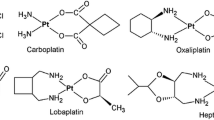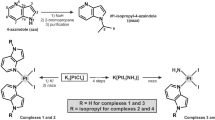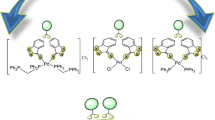Summary
The syntheses of dichlorobis(cycloalkylamine)platinum(II) complexes withcis andtrans cycloalkylamine ligands [cis-PtCl2(C3H5NH2)2 tocis-PtCl2(C8H15NH2)2 (3–8) andtrans-PtCl2(C7H13NH2)2 (9) andtrans-PtCl2(C8H15NH2)2 (10)] are described. The distinction betweencis andtrans isomers was achieved by1H-NMR spectroscopy. The antitumor activity was determined on the cell proliferation of the human MDA-MB-231 breast cancer cell line during long-term drug exposure. The complexes with small cycloalkylamine ligands (3–6) were inferior, those with large cycloalkylamine ligands were comparable (7) or superior (8) to cisplatin. Surprisingly, thecis/trans isomers7/9 and8/10 were equally active. All cycloalkylamine ligands were inactive. IR-spectroscopic studies showed that the size of the cycloalkylamine ring does not lead to significant differences in the Pt-Cl binding strength. Therefore it is assumed that the markedly stronger antitumor activity of the higher homologues,7–10, is not the result of a faster reaction with bionucleophils such as DNA. A possible explanation of the high activity of7–10 is the strong lipophilicity of the complexes. This assumption was confirmed by toxicity tests against confluent cultures.
Zusammenfassung
Die Synthese von Dichlorobis(cycloalkylamin)platin(II)-Komplexen mitcis- undtrans-ständigen Cycloalkylaminliganden [cis-PtCl2(C3H5NH2)2 biscis-PtCl2(C8H15NH2)2 (3–8) sowietrans-PtCl2(C7H13NH2)2 (9) undtrans-PtCl2(C8H15NH2)2 (10)] wird beschrieben. Eine Unterscheidung zwischencis- undtrans-Isomeren konnte mit Hilfe der1H-NMR-Spektroskopie getroffen werden. Die tumorwachstumshemmende Wirkung wurde im Langzeitversuch an der menschlichen MDA-MB-231 Brustkrebszellinie bestimmt. Die Komplexe mit kleinen Cycloalkylaminliganden (3–6) waren weniger, diejenigen mit großen Cycloalkylaminliganden vergleichbar (7) oder besser (8) wirksam als Cisplatin. Überraschenderweise waren diecis/trans Isomeren7/9 und8/10 gleich aktiv. Sämtliche Cycloalkylaminliganden waren unwirksam. IR-spektroskopische Untersuchungen zeigen, daß die Größe des Cycloalkylaminliganden zu keiner signifikanten Veränderung der Pt-Cl Bindungsstärke führt. Es wird angenommen, daß die deutlich stärkere Antitumoraktivität der höheren Homologen7–10 nicht auf eine schnellere Reaktion mit Bionucleophilen wie der DNA zurückzuführen ist. Eine mögliche Erklärung der hohen Aktivität von7–10 liegt in der starken Lipophilie der Komplexe. Diese Annahme wird durch Cytotoxizitätstests an stationären Kulturen gestützt.
Similar content being viewed by others
References
Connors T. A., Jones M., Ross W. C. J., Braddock P. D., Khokhar A. R., Tobe M. L. (1972) Chem. Biol. Interactions5: 415
Braddock P. D., Connors T. A., Jones M., Khokhar A. R., Mack D. H., Tobe M. L. (1975) Chem. Biol. Interactions11: 145
Connors T. A., Cleare M. J., Harrap K. R. (1979) Cancer Treat. Rep.63(9–10): 1499
Bernhardt G., Reile H., Birnböck H., Spruß T., Schönenberger H. (1992) J. Cancer Res. Clin. Oncol.118: 35
Kritzenberger J., Zimmermann F., Wokaun A. Inorg. Chim. Acta (submitted)
Kritzenberger J., Yersin H., Zabel M., Range K.-J. Inorg. Chim. Acta (submitted)
Howard-Lock H. E., Lock C. J. L., Turner G., Zvagulis M. (1981) Can. J. Chem.59: 2737
Lippman M. E., Monaco M. E., Bolan G. (1977) Cancer Res.37: 1901
Reile H., Birnböck H., Bernhardt G., Spruß T., Schönenberger H. (1990) Anal. Biochem.187: 262
Hartley F. R. (1973) Chem. Soc. Rev.2(2): 163
Chatt J., Duncanson L. A., Venanzi L. M. (1955) Inorg. Subst. React. PartI: 4456
Burdett J. K. (1977) Inorg. Chem.16: 3013
Kauffman G. B., Cowan D. O. (1963) Inorg. Synth.7: 239
Hicks C. P., Spiro M. (1985) React. Kinet. Catal. Lett.29(1): 27
Lock C. J. L., Zvagulis M. (1981) Inorg. Chem.20: 1817
Zanotti G., Del Pra A., Bombieri G., Tamburro A. M. (1978) Acta Cryst.B34: 2138
Bradford J. P., Faggiani R., Lock C. J. L. (1981) Acta Cryst.B37: 243
Cherchi V., Faraglia G., Sindellari L., Voltarel G., Siotran S., Furlani A., Ravalico L., Scarcia V. (1988) Platinum and other Metal Coordination Compounds in Cancer Chemotherapy, Martinus Nijhoff, Boston, p. 643
Ha T. B. T., Souchard J.-P., Wimmer F. L., Johnson N. P. (1990) Polyhedron9: 2647
Bancroft D. P., Lepre C. A., Lippard S. J. (1990) J. Am. Chem. Soc.112: 6860
Butour J.-L., Alvinerie P., Souchard J.-P., Colson P., Houssier C., Johnson N. P. (1991) Eur. J. Biochem.202: 975
Souchard J.-P., Ha T. T. B., Cros S., Johnson N. P. (1991) J. Med. Chem.34: 863
Rosenberg B., Van Camp L., Trosko J. E., Mansour V. H. (1969) Nature222: 385
Farrell N., Ha T. T. B., Souchard J.-P., Wimmer F. L., Cros S., Johnson N. P. (1989) J. Med. Chem.32: 2240
Hollis L. S., Amundsen A. R., Stern E. W. (1989) J. Med. Chem.32: 128
Cleare M. J., Hoeschele J. D. (1973) Platinum Metals Rev.17(1): 2
Sherman S. E., Lippard S. J. (1987) Chem. Rev.87: 1153
Lippert B. (1988) Gaz. Chim. Ital.118: 153
Lepre C. A., Lippard S. J. (1990) In: Eckstein F., Lilley D. M. J. (eds) Nucleic Acids and Molecular Biology, vol. 4. Springer, Berlin Heidelberg New York Tokyo p. 9
Reedijk J. (1987) Pure & Appl. Chem.59(2): 181
Alazard R., Germanier M., Johnson N. P. (1982) Mutat. Res.93: 327
Plooy A. C. M., van Dijk M., Lohman P. H. M. (1984) Cancer Res.44: 2043
Ciccarelli R. B., Soloman M. J., Varshavsky A., Lippard S. J. (1985) Biochemistry24: 7533
Roberts J. J., Friedlos F. (1987) Cancer Res.47: 31
Pascoe J. M., Roberts J. J. (1974) Biochem. Pharmacol.23: 1345
Bernges F., Holler E. (1988) Biochemistry27: 6398
Bernges F., Holler E. (1990) Eur. J. Biochem.191: 743
Koch M., Bernhardt G. (1991) J. Cancer Res. Clin. Oncol.117 [Suppl.]: 104
Author information
Authors and Affiliations
Additional information
In memory of Professor Dr. Günter Gliemann, late director of the Institut für Physikalische und Theoretische Chemie, Universität Regensburg.
Rights and permissions
About this article
Cite this article
Kritzenberger, J., Bernhardt, G., Gust, R. et al. Dichlorobis(cycloalkylamine)platinum(II) complexes structure activity relationship on the human MDA-MB-231 breast cancer cell line. Monatsh Chem 124, 587–604 (1993). https://doi.org/10.1007/BF00819526
Received:
Accepted:
Issue Date:
DOI: https://doi.org/10.1007/BF00819526




